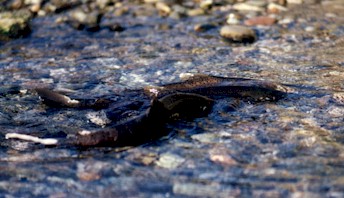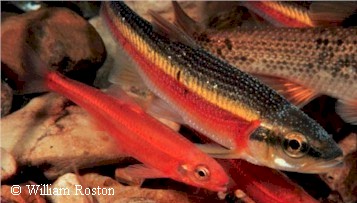|
| |
Fishes
Need Riparian Zones
Streamside vegetation
removal causes serious problems for fishes and other animals living in the water.
Overhanging vegetation and trees shade the stream channel, providing valuable temperature
regulation in both summer and winter. In summer, leaves and branches reduce the
amount of sunlight striking the stream, preventing an increase in water temperature.
Removing riparian vegetation can increase summer water temperatures by up to an
average of 3oC. Warmer water temperatures reduce the oxygen-carrying
capacity of the stream, as well as increase the incidence of disease. Warmer water temperatures reduce the oxygen-carrying
capacity of the stream, as well as increase the incidence of disease. Mature riparian vegetation provides streams with a regular
source of large organic debris, which benefits fishes by stabilizing streams, forming
pools and other habitat features, improving water aeration, and providing fishes with
cover and protection from predators. Once the riparian areas have been logged, existing
large organic debris is less stable and more likely to move downstream. This
process can result in the reduction of pools and the straightening of stream channels.
Probably no group of fishes has had their habitat
requirements as well researched and documented as Atlantic and Pacific salmon, fishes
which are totally dependent upon clean cool streams with loose gravel substrates.
Sediments from erosion can affect salmon and other fishes in numerous ways: |
 They can destroy
spawning habitat by covering the gravels needed to lay their eggs (as used by the pair of
spawning coho salmon at right). They can destroy
spawning habitat by covering the gravels needed to lay their eggs (as used by the pair of
spawning coho salmon at right).
 Sediments settling
out on spawning gravels will smother the eggs, or smother attached periphyton and benthic
macroinvertebrates needed by fry for food. One research team found that
benthic invertebrate density and biomass was decreased by up to 2/3 after streamside
logging. Sediments settling
out on spawning gravels will smother the eggs, or smother attached periphyton and benthic
macroinvertebrates needed by fry for food. One research team found that
benthic invertebrate density and biomass was decreased by up to 2/3 after streamside
logging.
 Suspended sediments also
interfere with the ability of salmonids to catch what prey is available, through reducing
visibility or forcing changes in movements and behavior. Suspended sediments also
interfere with the ability of salmonids to catch what prey is available, through reducing
visibility or forcing changes in movements and behavior. |

Spawning coho salmon: Skagit River, WA; Jay DeLong
photo
|
|

Tennessee shiner (left) and
rosyside dace (center) engaged in a multi-species spawning frenzy over a stoneroller's
gravel nest. The tail-end of the host stoneroller is visible to the right.
These species and many others are intolerant of siltation. |
|
Fish populations are differentially affected by riparian zone removal. As stream waters
become warmer, trout and other cold-water species decline in
number and biomass. Smaller fishes like minnows and darters disappear as gravel and
cobble substrates become silt-laden, denying them feeding and spawning habitat. They are
often replaced by more tolerant species, accompanied by a decrease in species diversity. |
|
The threats facing native
southestern U.S. fishes are stated in rather alarming terms in Southeastern Fishes
Council Regional Reports - 2000  : :
|
"Given the array of threats
that are reasonably anticipated, levels of imperilment in southeastern fishes will
significantly increase without significant efforts to recover habitats and
establish connected river refugia. The cumulative effects of human population growth may
push many southeastern fishes to levels of imperilment currently experienced by freshwater
mussels. Southeastern fishes have endured previous episodes of persistence-threatening,
large scale events (e.g.,pervasive water pollution prior to the Clean Water Act, era of
high dam construction). It is remarkable that some species have even persisted this long.
However, the rate, magnitude, and permanence of change across the southeastern landscape
has never been greater: more change will occur in the next two decades than during the
entire history of European colonization. That unprecedented level of pervasive stressors
will undoubtedly force marginally persisting fishes closer to extinction." |
|
© Robert Carillio s_r_enterprises@hotmail.com and Jay DeLong thirdwind@att.net
|

![]() :
: 